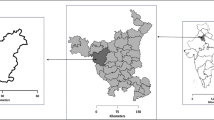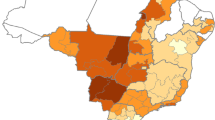Abstract
Epidemiology of human and animal brucellosis may depend on ecological conditions. A cross-sectional study was conducted to compare prevalence and risk factors of bovine brucellosis, and risky behaviours for the human infection between urban and agro-pastoral areas in Morogoro region, Tanzania. Cattle blood sampling and interviews using a structured questionnaire were conducted with farmers. Rose-Bengal test was conducted for the cattle sera, and positive samples were confirmed with competitive ELISA. Farm-level sero-prevalences were 0.9% (1/106, 95% CI 0.0–5.9%) and 52.9% (9/17, 95% CI 28.5–76.1%) in urban and agro-pastoral areas, respectively. The animal-level-adjusted prevalences were 0.2% (1/667, 95% CI 0.0–1.1%) and 7.0% (28/673, 95% CI 5.7–8.4%) in those areas. The final farm-level model including both areas found two risk factors: history of abortion in the herd (P < 0.01) and cattle grazing (P = 0.07). The animal-level risk factors in agro-pastoral areas were age (P = 0.04) and history of abortion (P = 0.03). No agro-pastoral farmer knew about Brucella vaccine. Agro-pastoralists generally had poorer knowledge on brucellosis and practiced significantly more risky behaviours for human brucellosis such as drinking raw milk (17.6%, P < 0.01) and blood (35.3%, P < 0.01), and helping cattle birth (100%, P = 0.04) than urban farmers (0, 0 and 79.2%, respectively). Intervention programs through education including both human and animal health particularly targeting agro-pastoralists would be needed.

Similar content being viewed by others
References
Al-Majali AM, Talafha AQ, Ababneh MM, Ababneh MM (2009) Seroprevalence and risk factors for bovine brucellosis in Jordan. Journal of Veterinary Science 10(1):61–65; https://doi.org/10.4142/jvs.2009.10.1.61
Alvarez J, Suaez JL, Garcia N, Serrat C, Perez-Sancho M, Gonzalez S (2011) Management of an outbreak of brucellosis due to B. melitensis in dairy cattle in Spain. Research in Veterinary Science, 90: 208-211; https://doi.org/10.1016/j.rvsc.2010.05.028
Assenga JA, Matemba LE, Muller SK, Malakalinga JJ, Kazwala RR (2015) Epidemiology of Brucella infection in the human, livestock and wildlife interface in the Katavi–Rukwa ecosystem, Tanzania. BMC Veterinary Research 11:189 (https://doi.org/10.1186/s12917-015-0504-8)
Banai M, Corbel M (2010) Taxonomy of Brucella. The Open Veterinary Science Journal 4:85–101
Corbel MJ (1997) Brucellosis: an overview. Emerging Infectious Diseases 3(2):213–221.
CRAN (2016) The Comprehensive R Archive Network. https://cran.r-project.org/. Accessed 9 Jan 2017
Dohoo IR, Martin W, Stryhn H E (2003) Veterinary epidemiologic research. Charlottetown, P.E.I.: University of Prince Edward Island
Ducrotoy MJ, Ammary K, Lbacha HA, Zouagui Z, Mick V, Prevost L, Bryssinckx W, Welburn SC, Benkirane A (2015) Narrative overview of animal and human brucellosis in Morocco: intensification of livestock production as a driver for emergence? Infectious Disease of Poverty 4:57. https://doi.org/10.1186/s40249-015-0086-5
Ducrotoy MJ, Bertu WJ, Ocholi RA, Gusi AM, Bryssinckx W, Welburn S (2014) Brucellosis as an emerging threat in developing economies: lessons from Nigeria. PLoS Negl Trop Dis 8(7), e3008. https://doi.org/10.1371/journal.pntd.0003008
Food and Agriculture Organization of the United Nations (FAO) Statistics Division, “FAOSTAT: the Statistical Database of FAO,” Annual Population. http://www.fao.org/faostat/en/#data/OA. Accessed 31 Jan 2017
Ficht T (2010) Brucella taxonomy and evolution. Future Microbiol 5(6):859–866; https://doi.org/10.2217/fmb.10.52
Gall D, Nielsen K (2004) Serological diagnosis of bovine brucellosis: a review of test performance and cost comparison. Revue Scientifique et Technique International Office of Epizootics 23(3):989-1002
Halekoh U, Højsgaard S, Yan J (2006) The R Package geepack for Generalized Estimating Equations. Journal of Statistical Software 15(2):1-11
James LW (2013) Studies on Human Brucellosis in the Mikumi Selous Ecosystem, Morogoro, Tanzania. M.Sc. Dissertation. Tanzania: Sokoine University of Agriculture
Jergefa T, Kelay B, Bekana M, Teshale S, Gustafson H, Kindahl H (2009) Epidemiological study of bovine brucellosis in three agro-ecological areas of central Oromiya, Ethiopia. Revue Scientifique et Technique-Office International des Epizooties, 28, pp. 933-943
Jiwa SFH, Kazwala RR, Tungaraza R, Kimera SI, Kalaye WJ (1996) Bovine brucellosis serum agglutination test prevalence and breed disposition according to prevalent management systems in the Lake Victoria zone of Tanzania. Preventive Veterinary Medicine, 26, 341–346; https://doi.org/10.1016/0167-5877(95)00543-9
John K, Kazwala R, Mfinanga GS (2008) Knowledge of causes, clinical features and diagnosis of common zoonoses among medical practitioners in Tanzania. BMC Infectious Diseases 8:162. https://doi.org/10.1186/1471-2334-8-162
Kahler SC (2000) Brucella melitensis infection discovered in cattle for first time, goats also infected. Journal of the American Veterinary Medical Association 216(5):648
Kadohira M, McDermott JJ, Shoukri MM, Kyule MN (1997) Variations in the prevalence of antibody to Brucella infection in cattle by farm, area and district in Kenya. Epidemiology & Infection 118:35–41
Makita K, Fèvre EM, Waiswa C, Eisler MC, Thrusfield M, Welburn SC (2011) Herd prevalence of bovine brucellosis and analysis of risk factors in cattle in urban and peri-urban areas of the Kampala economic zone, Uganda. BMC Veterinary Research 7:60. https://doi.org/10.1186/1746-6148-7-60
Makita K, Fèvre EM, Waiswa C, Eisler MC, Welburn SC (2010) How human brucellosis incidence in urban Kampala can be reduced most efficiently? A stochastic risk assessment of informally-marketed milk. PLOS ONE 5(12):e14188. https://doi.org/10.1371/journal.pone.0014188
Makita K, Fèvre EM, Waiswa C, Kaboyo W, Eisler MC, Welburn SC (2011) Evidence-based identification of the most important livestock related zoonotic diseases in Kampala, Uganda. The Journal of Veterinary Medical Science 73(8):991–1000
McDermott JJ, Arimi SM (2002) Brucellosis in sub-Saharan Africa: epidemiology, control and impact. Veterinary Microbiology 90(1–4):111–134
McDermott J, Grace D, Zinsstag J (2013) Economics of brucellosis impact and control in low-income countries. Revue scientifique et technique (International Office of Epizootics) 32(1):249–61
Mdegela RH, Kusiluka LJM, Kapaga AM, Karimuribo ED, Turuka FM, Bundala A, Kivaria F, Kabula B, Manjurano A, Loken T, Kambarage DM (2004) Prevalence and determinants of mastitis and milk-borne zoonoses in smallholder dairy farming sector in Kibaha and Morogoro Districts in Eastern Tanzania. Journal of veterinary medicine. B, Infectious diseases and veterinary public health 51:123–128; https://doi.org/10.1111/j.1439-0450.2004.00735.x
Mkoma SL, Mjemah IC (2011) Influence of meteorology on ambient air quality in Morogoro, Tanzania. International Journal of Environmental Sciences 1(6):1107-1115
Olsen SC, Stoffregen WS (2005) Essential role of vaccines in brucellosis control and eradication programs for livestock. Expert Rev Vaccines 4:915–928; https://doi.org/10.1586/14760584.4.6.915
Pérez-Sancho M, García-Seco T, Domínguez L, Álvarez J (2015) Control of Animal Brucellosis - The Most Effective Tool to Prevent Human Brucellosis. In: Updates on Brucellosis, Baddour MM (editor), Rijeka, Croatia: INTECH. https://doi.org/10.5772/61222
Portanti O, Tittarelli M, Di Febo T, Luciani M, Mercante MT, Conte A, Lelli R (2006) Development and validation of a competitive ELISA kit for the serological diagnosis of ovine, caprine and bovine brucellosis. Journal of veterinary medicine. B, Infectious diseases and veterinary public health 53:494–498
Refai M (2002) Incidence and control of brucellosis in the Near East region. Veterinary Microbiology 90:81–110
Samaha H, Al-Rowaily M, Khoudair RM, Ashour HM (2008) Multicenter study of brucellosis in Egypt. Emerging Infectious Diseases, 14: 1916-1918. https://doi.org/10.3201/eid1412.071452
Shirima GM (2005) The Epidemiology of Brucellosis in Animals and Humans in Arusha and Manyara Regions in Tanzania. Ph.D. thesis. UK: University of Glasgow
Shirima GM, Cleaveland S, Kazwala RR, Kambarage DM, Nigel F, McMillan A, Kunda J, Mfinanga GS, Fitz Patrick JS (2007) Sero-prevalence of brucellosis in smallholder dairy, agropastoral, pastoral, beef ranch and wildlife animals in Tanzania. Bulletin of Animal Health and Production in Africa 55(1):13-21
Strausbaugh, Larry J, Berkelman Ruth L (2003) Human illness associated with use of veterinary vaccines. Clinical Infectious Diseases 37(3): 407-414; https://doi.org/10.1086/375595
Swai ES, Schoonman L (2012) A survey of zoonotic diseases in trade cattle slaughtered at Tanga city abattoir: a cause of public health concern. Asian Pacific Journal of Tropical Biomedicine 2(1):55–60; https://doi.org/10.1016/s2221-1691(11)60190-1
Temba P (2012) Seroprevalence of Brucella Species Infections and Associated Risk Factors in Wildlife-Livestock Interface: A Case Study of Mikumi–Selous Ecosystem. M.Sc. Dissertation. Tanzania: Sokoine University of Agriculture
Thrusfield M (2005) Veterinary Epidemiology Third edition. Blackwell Science ltd, Oxford, UK
Zinsstag J (2012) Convergence of Ecohealth and One Health. EcoHealth 9, 371-373; https://doi.org/10.1007/s10393-013-0812-z
Zinsstag J, Schelling E, Waltner-Toews D, Whittaker M, Tanner M (2015) One Health: the theory and practice of integrated health approaches, Croydon: CPI Group (UK) Ltd
WHO (2006) The Control of Neglected Zoonotic Diseases: A Route to Poverty Alleviation. WHO Press, Geneva
Acknowledgements
This work was supported by the Ministry of Education, Culture, Sports, Science and Technology of Japan under a research project “Development of rapid diagnostic kits for infectious pathogens in industry animals and establishment of effective control methods through global analysis of transmission routes (Grant Number S1391001)”, of “2013 support grant for establishment of strategic research platform for private universities”. SA thanks the Japan Overseas Cooperation Volunteer (JOCV) program of Japan International Cooperation Agency (JICA) for funding preparatory phase of the project. The authors would like to thank all the farmers who participated in the survey. We also thank Morogoro municipal and Mvomero district officials and veterinary and livestock field officers for their cooperation during the implementation of this study.
Author information
Authors and Affiliations
Corresponding author
Ethics declarations
Ethical statements
This study was approved by the Ethical Committee of the Graduate School of Dairy Science, Rakuno Gakuen University (Approval Number 16-3). Permission to conduct the study in Morogoro municipality and Mvomero district was sought and granted by municipal and district executive officers (reference numbers E.10/MMC-138/185 and MVDC/C.80/4 VOLII/126, respectively). Verbal informed consent was obtained from each participant after livestock field officers explained the aim of the study.
Rights and permissions
About this article
Cite this article
Asakura, S., Makingi, G., Kazwala, R. et al. Brucellosis Risk in Urban and Agro-pastoral Areas in Tanzania. EcoHealth 15, 41–51 (2018). https://doi.org/10.1007/s10393-017-1308-z
Received:
Revised:
Accepted:
Published:
Issue Date:
DOI: https://doi.org/10.1007/s10393-017-1308-z




